

I have been using 6 volt RV batteries for a very long time. My previous set of batteries, four 6 volt Trojan T105 batteries lasted ten years. My set of batteries before that were two 6 volt Interstate batteries, I sold them after one year of use. My set of batteries before that were four Trojan T105 which I sold after five years of use. Previous to that, I used 12 volt deep cycle RV batteries and the RVs before that was more 12 volt deep cycle batteries.
Having your batteries lasting ten years and selling another set at five years you have to be happy with the batteries. You will hear many stories of batteries not lasting very long, two to four years. The two Interstate batteries were sold when I sold an RV, they had less capacity than the Trojan T105, and they didn't meet our needs.
We do use the batteries, they are not just sitting around not being used (we RV). We do a lot of dry RVing or boondocking (no electrical connections). So when we are using the RV, we use the TV, DVD, recharging camera equipment, computers, cell phones, hair dryers, microwave oven, etc.
I also maintain the batteries' regularity; checking fluid levels, not using the power below 50% level of capacity, charging with solar, etc., and I do leave the batteries in the RV year round. Most of the time the recharging of the batteries is maintained by solar, if we get a heavy snow fall, I will use a city power connection as the local temperature gets down to -20 degrees Celsius (-4 degrees Fahrenheit) during winter. The batteries are very heavy to remove and put back in every year (for me).
Lead acid batteries were the standard in RVs for many years, and today many RVers are still using lead acid batteries, but today you have a choice of:
Everyone's needs are not the same and what's correct for one RVer may not be the best choice for another RVer. Someone that does not dry camp or boondock and only RV when connected to a campground power connection will have different needs compared to someone that does dry camp or boondock. We are RVers who do a lot of dry camping or boondock RVing.
Over a decade ago Trojan had a chart on their website that showed a deep cycle lead acid battery being discharged down to 50% and then recharged would have a life cycle of about 300 charges, a battery only being discharged to 85% (15% DoD) and then recharged had a life cycle of about 3000 cycles. So keeping your battery from getting down to 50% does extend your battery life cycles.
The SiO2 Silicon Dioxide Batteries being discharged down to 50% and then recharged would have a life cycle of about 3000 charges. With discharge to 85% (15% DoD), then recharge, Silicon Dioxide batteries have a life cycle of 6700 cycles.
Some studies have shown that most RVs are over weight! So having two or more batteries could be an issue for some RVers.
Some RVers only need some electrical power for running their fridge and lights (my first RV only used electrical power for lights) while other RVers also need power for many devices and needs such as TV, DVD, radio, computers, furnace, CPAP machines (Continuous Positive Airway Pressure (CPAP) therapy is a common treatment for obstructive sleep apnea), etc.
Oxygen Concentrators & Generators, some RVers use oxygen concentrators which are often referred to as oxygen machines, oxygen generators, or O2 concentrators. They provide a cost-effective way for oxygen therapy patients to supplement their oxygen needs without the need of bulky, heavy oxygen tanks. Unlike tanks, concentrators do not run out of oxygen. A personal unit pulls-in regular room air, filters out some other gases present and delivers concentrated, medical grade oxygen.
Some RVs do not have space for more than one battery. My first RV only had space for one battery, other RVs I have had there was space for two batteries, my last two RVs had space for four or more batteries (but weight can then become an issue).
I have met RVers that said cost isn't an issue and would replace their (six) RV deep cycle batteries every two to three years. I think most of us are not in the same position as these RVers and cost over a lifespan for the batteries is an important decision.
I am now using SiO2 Silicon Dioxide Batteries, four 6 volt batteries.
SiO2 Silicon Dioxide Batteries have a unique chemistry. The non-corrosive electrolyte in SiO2 batteries forms crystalline salts when charged/discharged. SiO2 batteries use 95% less sulphuric acid than Lead Acid batteries. They are essentially a "dry-cell" battery with no liquid to freeze, spill or off-gas. Eliminating most of the acid, means that the lead plates last longer and weigh less. Sulphation does not build up and reduce capacity over time. With the crystalline structure, they can also be used in any orientation.
Regular fluid checks and winter removal is no longer required with SiO2 batteries.
DoD is Depth of Discharge.
Charging Cycles, the previous battery I used had a lifespan of 300 (50% DoD) to 3000 (85% DoD) cycles. The Silicon Dioxide batteries 2800 (50% DoD) to 6700 (85% DoD) cycles. So, the lifespan is much longer with a deeper DoD.
Weight: Trojan is 62 pounds, SiO2 is 72 pounds. My battery configuration went up 40 pounds.
Nominal Capacity: Trojan is 225 Ah (Amp hours) @ 20 Hour rating. SiO2 is 260 Ah (Amp hours) @ 20 Hour rating. SiO2 has more capacity in about the same space.
Capacity per pound: Trojan is 3.62 Ah per pound, SiO2 is 3.61 Ah per pound, about the same.
Useable Capacity per Pound (you most likely have not heard of this rating, I will explain). For Trojan, I calculate using 225 Ah, 62 pounds and 50% DoD. For SiO2 I calculate using 260 Ah, 72 pounds and 80% DoD. You could discharge the SiO2 batteries to 80% of their power and still have 1500 cycles, outperforming the Trojans at 50%.
UCP = (battery capacity) times (DoD) divided by (battery weight)
UCP (Useable Capacity per Pound) for Trojan is 1.81 Ah per pound while SiO2 is 2.88 Ah per pound. The SiO2 has 59% more useable capacity per pound than Trojan. If RV weight is important then you want to look at this ratio.
Why is UCP important? If weight is an issue for your RV, then a higher UCP is very important, you could get a smaller, lighter battery with the same capacity of Ah.
This can also be true for space, if you have limited space for your batteries but also need more battery capacity, look for a battery with more usable Ah in the same space. Example is getting four SiO2 batteries instead of six lead acid batteries.
Operation Temperature: Trojan is -4°F to 113°F (-20°C to +45°C), at temperatures below 32°F (0°C) maintain a state of charge greater than 60% (not 50%). SiO2 is -40°F to 149°F (-40°C to +65°C), SiO2 is fully usable in the temperature range. For winter RVing or cold weather RVing the SiO2 has a much larger temperature operating range.
So if we were going on a dry RVing trip (no power, no solar, no generator) how much power can I use before I must recharge the batteries?
| Trojan | SiO2 | |
| # of batteries | 4 | 4 |
| Battery voltage | 6 volts | 6 volts |
| Amp/Hour per battery | 225 | 260 |
| Useable Amp/Hour 4 battery 12 volt configuration | 225 (50% useage) | 416 (80% useage) |
225 Amp/Hours to 416 Amp/Hours comparison, with SiO2 batteries I have 84% more useable power for the trip before I must recharge the batteries. For a weekend RVer this could mean staying out for another day or two.
The T105 and SiO2 batteries side by side ↓

Comparing the height, SiO2 a little bit higher ↓
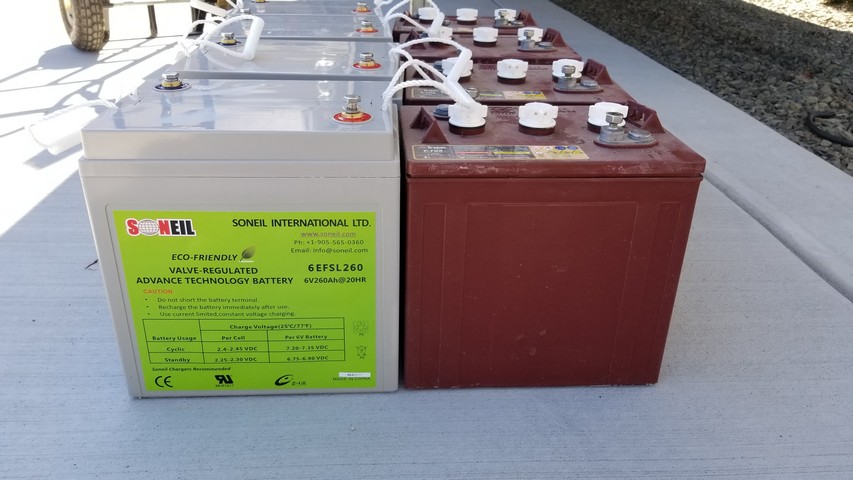
Changing your batteries can be very dangerous, so if you do not know how, stop and get a professional that knows!
This is not a full step by step set of instructions for changing your batteries!
Turn off the power to the RV, disconnect the power cable going to the electrical outlet ↓
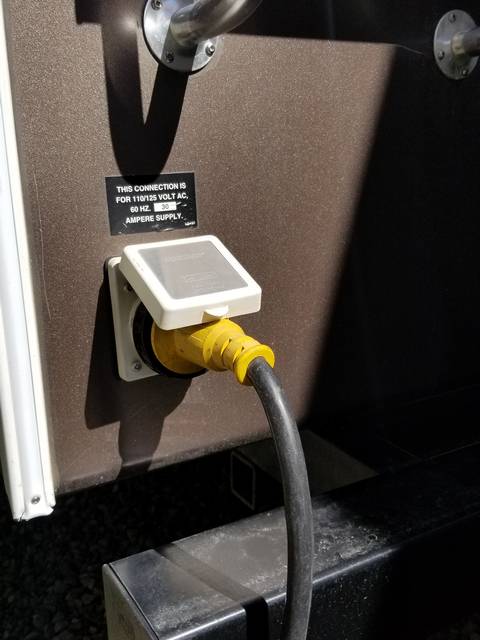
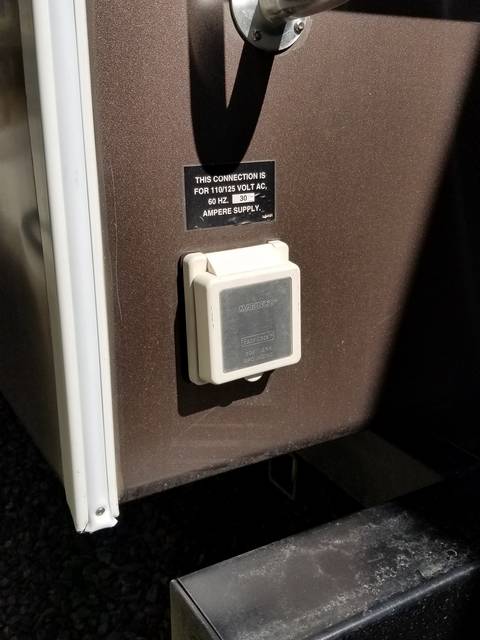
Turn off the 12 volt power to your RV, I have four switches, a master that is not everything, two for solar charging, and a true master switch for what the master doesn't do. The RV master cutoff switch ↓
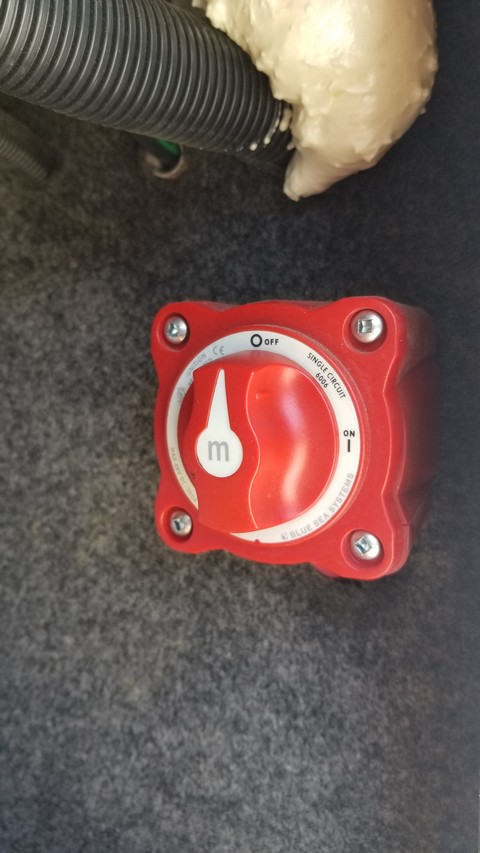
Solar cutoff switch ↓
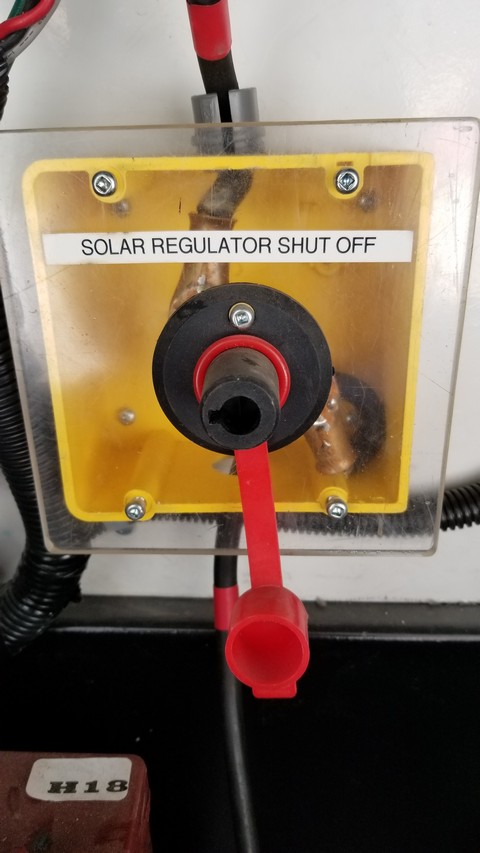
More cut off switches ↓
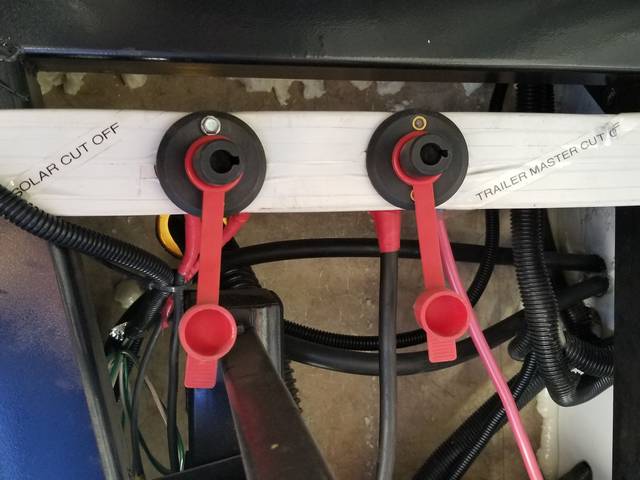
This step depends on your current battery configuration and if you are changing from 12 volt to 6 volt or 6 volt to 6 volt batteries. As there are many configurations I will not be listing all the combinations available. For my RV, I was changing from four 6 volt to four 6 volt so my wiring did not change.
Draw a diagram on how your wiring/batteries will be, colour code the wires/cables (did you notice the red/black electrical tape?).
Image of my completed wiring and new SiO2 batteries ↓
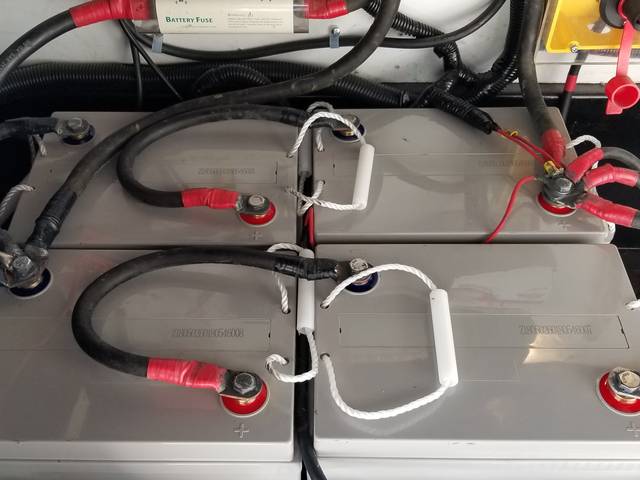
With the lead acid batteries you are limited with the number of connectors you can put on a terminal ↓ See right side positive terminals and compare to above image ↑
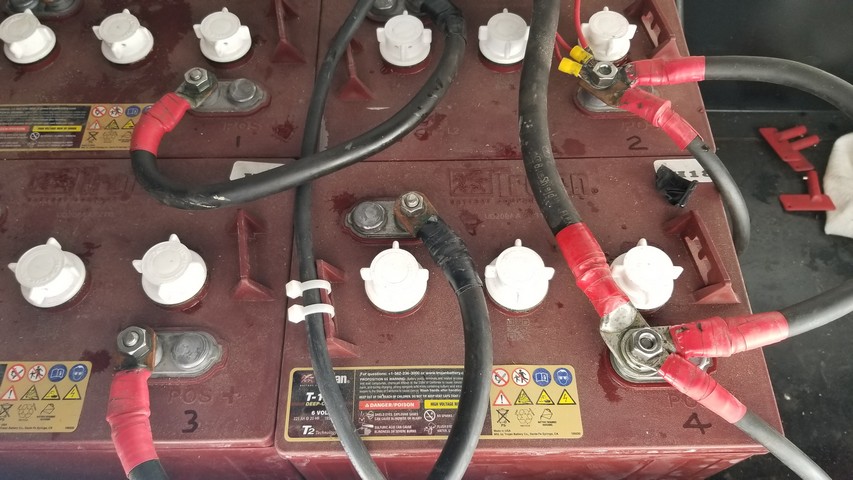
SiO2 terminal, use the length of bolt as required for the number of connectors required. Note: the bolt can be too long and damage the battery ↓
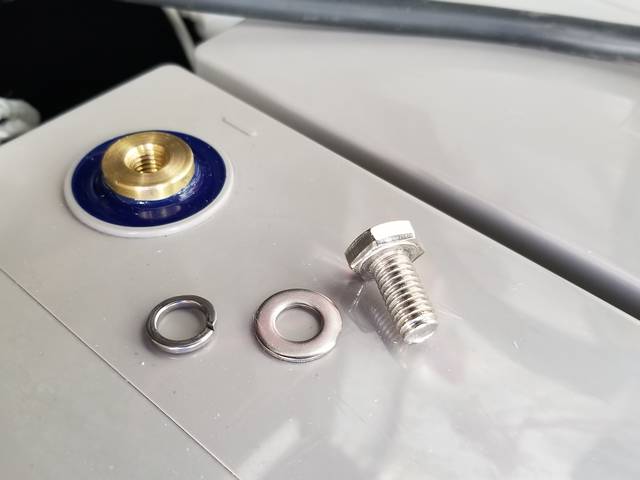
The charging settings for your battery charger most likely have to be changed! SiO2 batteries require different settings than lead acid or what ever you had before.
For the SiO2 batteries settings I used:
To change the charging settings for my solar regulator, I had to change some DIP switches ↓
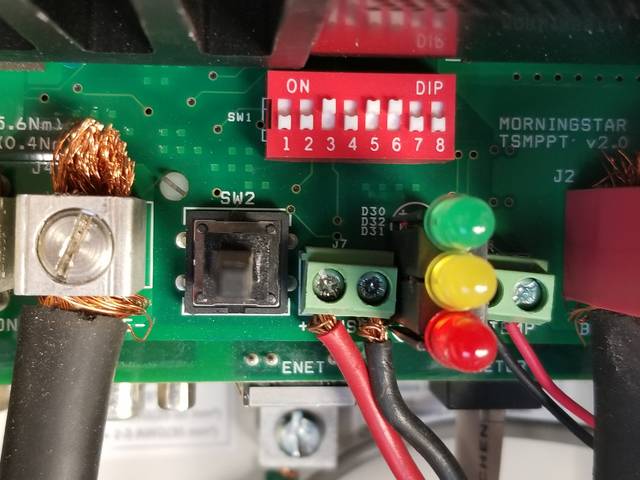
For the Magnum inverter/charger the changes were made via the control panel ↓
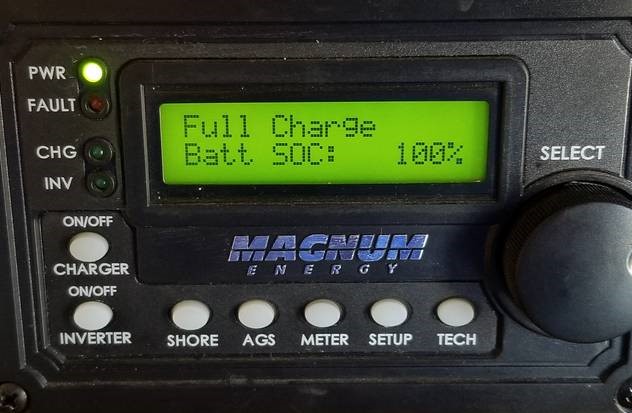
After about a year (2020) of using the SiO2 batteries, I'm I happy with them - Yes! Having more useable power is great when the weather is not behaving, I prefer not to use a generator. I do have a lot of solar on the RV but I have been in situations where the sun does not fully charge the batteries every day. The extra capacity enables us to continue RVing in these poor weather conditions without the generator. I have been with friends when their RV had to be recharged, with the SiO2 batteries and solar I was able to recharge their batteries from my RV without using a generator, and we continued RVing.
Would I recommend the SiO2 batteries for RV use? Yes for most RVers, No for the RVer that only RVs for two weeks a year with full hookups.
Azimuth Solar Products Inc.
1050 Richter Street,
Kelowna, British Columbia,
Canada, V1Y 2K5
Toll-free: 1.888.252.2452
Email sales: info@azimuthsolar.ca
Website: https://azimuthsolar.ca/ (Canada)
https://www.azimuthsolarproducts.com/ (USA)
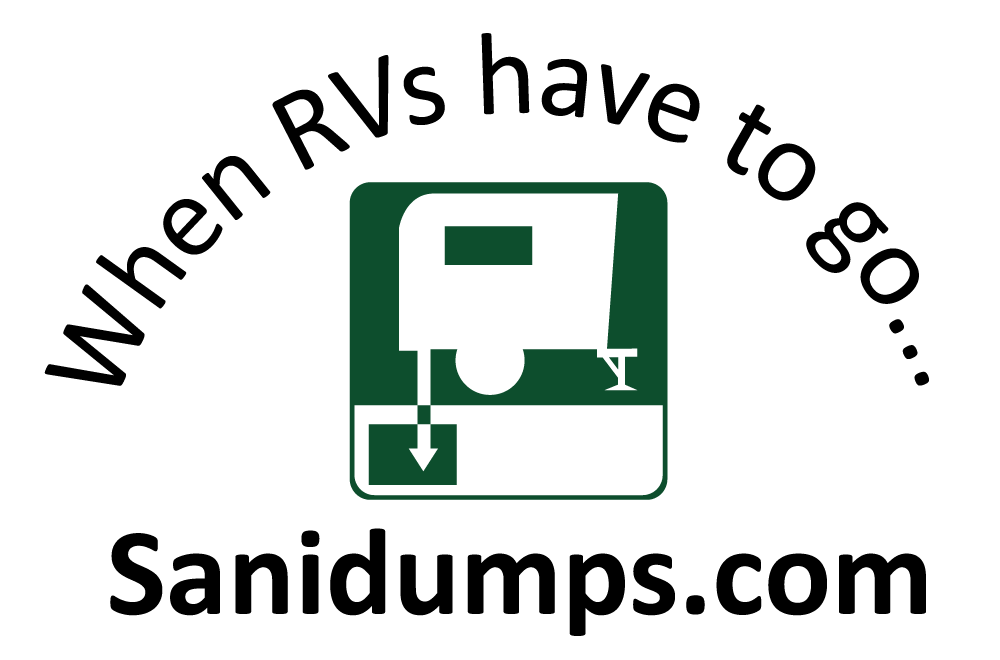
National Day Calendar
✔ Mark your calendar,
June 7 is
National RV Day,
Let's go RVing!
The type of recreational vehicle dump stations you will find on Sanidumps.com include: private, public, RV park, non-park, municipal, truck stop, rest stop, campground, camping, resort, commercial, pay, donation, waste disposal, and free.
It is important to dispose of human waste properly when RVing. The RV dump station, dump point, or sanidump station you choose to empty your gray and black water holding tanks is up to you; we're hoping that you will choose an approved dump station site that's green and environmentally friendly, using an environmentally sound method.
Do you need to know where to dump your holding tanks when your RV is on the road? Now you can know where the RV dump Stations are while traveling with a e-book. More information about the RV Dump Station location e-book.
Although efforts are made to make sure of the accuracy of the information presented, Sanidumps.com shall have neither liability nor responsibility to any person or entity with respect to any loss or damage caused, or alleged to be caused, directly or indirectly by the information contained here.
Sanidumps.com is not affiliated in any way with any place/location listed on this site. Fees are subject to change; availability and prices can and do change.
We thank all the RVers that have contributed information :-)
The Sanidumps.com Team
Serving the RV community for over 18 years
Sanidumps.com - When RVs have to go...™
© 2006 - 2024 Sanidumps.com - All rights reserved.
The content contained on this website may be used for personal reference only and may not be reproduced in any form without prior written consent permission from Sanidumps.com
Australia, Canada, Mexico, New Zealand, United States & more...